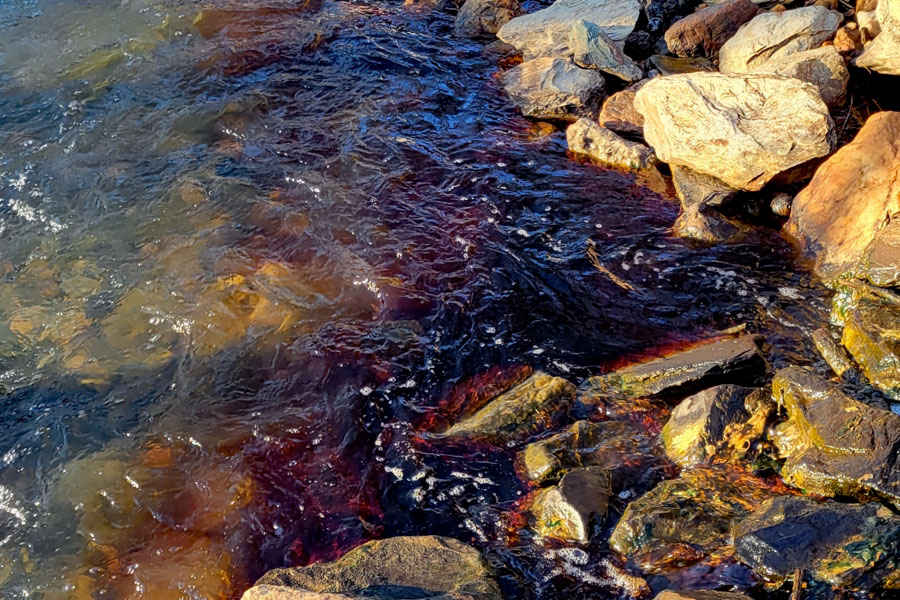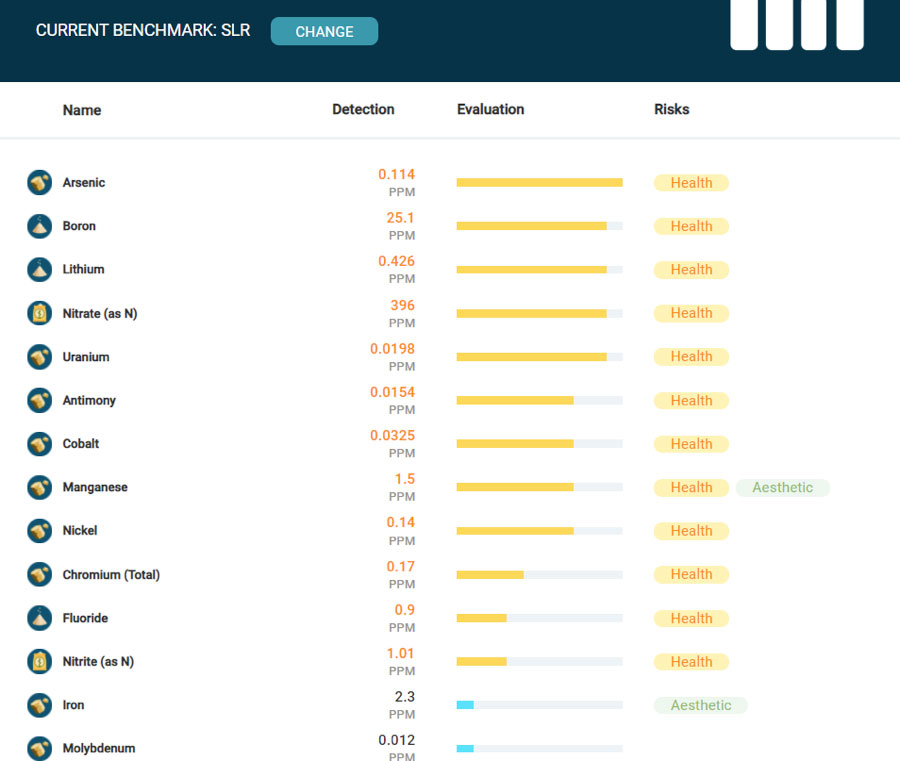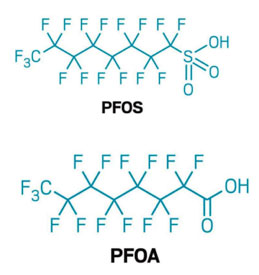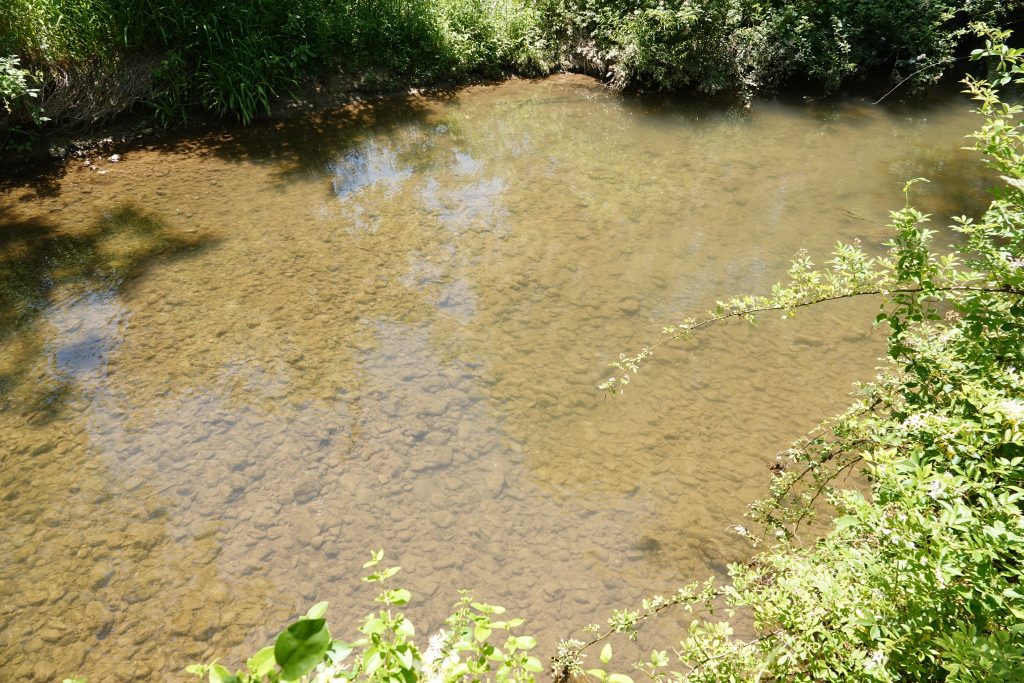April 2022 update – It’s worse than we thought.

Modern Landfill’s wastewater discharge permit, issued by PA DEP, sets limits on the amount and type of toxic substances that the landfill may dump into Kreutz Creek. In recent years, Modern has exceeded these limits without warning residents to not drink the water, wade or fish in the creek. In addition, there are many more substances in the leachate from Modern that are harmful to human health that are not limited through the permitting process.
Video at Outfall 001 of Modern Landfill
Click on the “start” icon above to experience the process of adding leachate to our creek.
To understand what components of the leachate could be of concern, a broad-spectrum water test was performed on the effluent coming from the pipe in the above video, and results are presented in Chart A below. The length of the yellow bar indicates the degree of danger to human health as determined from a benchmark for tap water used by the water testing lab, SLR. This benchmark takes into account the type and concentration of each anolyte.
Chart A – Contaminants of Concern Measured at Outfall 001

Of the anolytes of concern, only Boron and Nitrate are limited in their concentration and total mass at the outfall pipe by PA DEP in Modern Landfill’s discharge permit. The permitting process is on a 5-year cycle that begins with the landfill operator disclosing the composition of its discharge to PA DEP, and on that basis, DEP then sets limits to the various components that the landfill must meet during the next 5 years. In the most recent permit application by Modern Landfill, Republic Services didn’t disclose the amount of Lithium or Uranium going into the creek, so DEP might not have had the opportunity to consider those if concerned residents hadn’t brought those elements to their attention.
The units of concentration in Chart A are parts per million (PPM). One PPM = 1000 parts per billion (PPB). Chart B below lists the same anolytes of concern in Chart A in the same order, but reports in PPB and has more detail of the degree of concern with each. A blank in any column means that no limits or benchmarks have been set.
Chart B – Contaminants of Concern from Chart A with Details

Arsenic concentrates in the body with time, which is probably why the SLR and EPA MCLG are both zero for it. Uranium also should not be detectable in the sample according to either benchmark.
The point is that Arsenic, Lithium, Uranium, and other toxic materials are going into Kreutz Creek at loadings considered unsafe, and there is at the moment an attempt to control only Boron and Nitrates. Modern Landfill will claim that the creek and all of its tributaries will eventually dilute the most toxic substances to the point of no concern. However, if as for Arsenic and Uranium, that point is zero PPB, how many million gallons per day does that take?
The Riverkeeper Association is monitoring the water quality at four points in Kreutz Creek on a monthly basis. Preliminary results suggest that the many tributaries between Modern Landfill’s discharge point and Emig Park, where children wade in the water and folks fish, may not be sufficient to dilute the leachate to the point of being considered safe. See: [https://lowersusquehannariverkeeper.org/educate/issues-2/landfills/modern-landfill-expansion/ues-2/landfills/]

However, there is a class of toxic contaminants that are in Modern Landfill’s leachate that are potentially more damaging to human health than even those discussed above. These are known as PFAS, per- and poly-fluoroalkyl substances. The two most studied PFAS, having been used in industry since the early 1940’s, are perfluorooctanoic acid (PFOA) and perfluorooctane sulfonic acid (PFOS.) The structures of these are shown to the right.
Carbon backbones shielded by fluorine as in the case of these PFAS are known to be highly stable and do not degrade in nature, so they have come to be known as “Forever Chemicals.” Unfortunately, some PFAS have been found to be so dangerous to human health that tiny fractions of one part per billion in water can cause cancer or other serious disease.
Learn more about PFAS here: [https://www.epa.gov/pfas/pfas-explained]
PFOS is a strong water repellant, and was the active component in Scotchgard and other water and oil repellant applications for fabrics and rugs. Most other PFAS have properties similar to PFOS and are being widely used today in fast food wraps and containers to prevent staining and leakage, and so they are ending up in landfills where they concentrate. From there, they enter the biosphere when leachate contaminates wells or surface water.
The leachate entering Kreutz Creek was tested for 29 PFAS, and 6 of these showed up in quantities to be of high concern. See Chart C.
Chart C – PFAS Measured at Outfall 001 Pipe

Chart D adds details to the reasons for concern. Note that the units are in parts per billion, and though 1.8 PPB of PFOA would seem like a tiny amount, it is 900 times the loading at which it is expected to be a problem for human health.
Chart D

Solid waste containing PFAS, such as food wraps and containers, should not be put in landfills where they will concentrate and subsequently enter the biosphere to harm people. PFAS would, however, be destroyed in an incineration process. Waste-To-Energy plants would be the ideal disposal method, as they are already equipped to handle the slightly acidic flue gas that would result. Treatment with a lime slurry or powder, common in WTE processing, would normalize the Ph and combine the fluorine with calcium to form fluorite, an inert mineral.
But Republic Services is building a new leachate treatment plant in response to DEP’s Consent Order. Won’t that take care of the PFAS? Well, if it does it’s not by design. Republic didn’t disclose to DEP that it was discharging PFAS into Kreutz Creek in its applications for either its renewed Water Quality Management Plan or its renewed Wastewater Discharge permits. As a result, the leachate treatment plant that DEP approved was not designed to remove PFAS.
But let’s say that luck is with us and the new leachate treatment plant, when it’s built in mid to late 2023, removes all of the PFAS. That’s good, right? Well, the leachate treatment plant that Republic Services has designed doesn’t destroy the PFAS. It concentrates them, and that concentrate must be safely disposed of. The concentrate will be a 30,000 gallon per day stream that will be ten times higher in PFAS, Arsenic, Uranium, etc. than is measured going into Kreutz Creek today. The Springettsbury Wastewater Treatment Facility, where Modern Landfill often takes leachate for disposal can’t possibly handle anything like that. Republic’s Water Quality Management Plan says it will be “disposed of off-site.” However, Republic isn’t telling anyone, including DEP, who will be responsible and how that disposal will take place, so nobody but Republic knows whose water the offensive materials will show up in or into whose old gas well the leachate concentrate will be injected until it happens.
The best way to lower the pollution of our streams and wells by PFAS and other toxins is to stop putting any more of them in the landfill in the first place, so there’s less to harm our children and grandchildren. Cap and close the landfill – that will stop rain water from percolating through the trash, greatly lowering the volume of leachate, now flowing into Kreutz Creek at a rate of 200,000 gallons per day.
There has been no greenfield construction of a municipal solid waste (MSW) landfill in PA in over 25 years because municipalities have chosen not to put up with the disastrous pollution and damage to their infrastructure and farm lands that inevitably results. See: [The Waste Industry Wants More Highly Profitable Landfills But They Are Not Being Built] Toxic leachate, poisoning our wells, streams and rivers, is a major part of that story. Waste-To-Energy plants like the one our own trash ends up in do not produce leachate. Leachate is unnecessary, and so are MSW landfills.
The original post from August 2020 appears below:


Leachate is a particularly odiferous “tea” produced when rain water filters down through a landfill, picking up soluble materials from the decomposing wastes. If there are hazardous chemistries caused by the decomposition or native to the waste, including pesticides, solvents and toxic heavy metals, the resulting leachate can be extremely harmful to human and aquatic life and special treatment is necessary to make it harmless if it will be released into streams or rivers.
At Modern Landfill, leachate is combined with groundwater contaminated with hazardous waste pumped from under the 66-acre Superfund Site and also condensate from landfill gas, then treated and dumped into Kreutz Creek, which winds through much of Lower Windsor and Hellam Townships, empties into the Susquehanna River above water intakes for York Water System reservoirs, and then into the Chesapeake Bay.
Modern’s National Pollutant Discharge Elimination System permit, PA 0046680 issued by PA DEP, requires measurement and recording of certain substances and properties. The limits on those that DEP chooses are allegedly that which is necessary to protect the creek and people living nearby, at least to the extent of the current very minimum regulations passed by PA and US legislatures.
The permit does not place limits on all of the substances or properties. For instance, lead, copper and tetrachloroethylene are measured but have no limits set in quantity or concentration, even though PA Title 25 Chapter 93 instream water quality standards control copper closely and lead and TCE are well known as health hazards. PA Code 25 92a.41(c) forbids discharging “…substances that produce an observable change in the color… of the receiving water.” Yet, no limits are placed on the color change in Modern’s discharge permit.
The history of the landfill’s leachate discharge into Kreutz Creek can be found in Electronic Discharge Monitoring Reports (eDMR). These are monthly reports of the composition and quantity of what is being dumped into Kreutz Creek. The eDMR from March and April of 2020 can be found here [Click to View Document].
If control limits are set, they appear in the eDMR. What is concerning is that there are at least three items that are regularly out of compliance with these limits. “Out of compliance” means illegal, as in subject to criminal and civil penalties according to Modern’s permit terms:
Boron
Boron is one of those elements whose compounds are beneficial in minute amounts, but too much can damage the stomach, intestines, liver, kidneys and brain. The amount of boron added to Kreutz Creek started rising in 2013, became excessive in 2017, limits were first set by DEP in Feb 2020 and Modern Landfill has been out of compliance ever since as of this writing. By March of 2020 it tested at over three times the average monthly permitted limit.
Osmotic Pressure
This is a catch-all measurement of how much “stuff” is dissolved in the leachate. Technologists normally think of high salt content when they see high osmotic pressure, but it can be sugars, alcohols, or almost anything that dissolves in water. By itself, high osmotic pressure can’t tell one if a toxic situation exists, but it clearly says that too much of something that doesn’t belong in a creek is being added. Osmotic Pressure has been rising over the years and in late 2017 began exceeding the statutory limits. By March of 2020 it exceeded twice the monthly average permitted.
Fecal Coliform
This is what it sounds like – bacteria from you-know-where. Most often this measurement is a surrogate for the presence of other much more pathogenic organisms like viruses, giardia, cryptosporidium, salmonella, etc. The levels were generally okay until May of 2019. By March of 2020 average for the month was greater than 32 times the maximum permitted count.
In January of 2020, the general manager of Modern Landfill was asked what he did with leachate that didn’t meet the terms of his permit for discharge. He replied that he trucked it to the Springettsbury Wastewater treatment plant. Apparently, that is not correct. It is ending up in our waterways.
Leachate has been dumped into Kreutz Creek since at least 1976, when hazardous liquids were found seeping out of the then 66 acre landfill, and even with DER/DEP guidance, Modern Landfill still hasn’t figured out how to make it safe for the residents or the waterways.
If Republic builds a second landfill as they have proposed, they will likely apply for a greatly increased tons/day tipping rate, as they did for the Conestoga landfill, the other landfill managed by the current General Manager. The profits from NYC, Philadelphia, NJ and MD solid waste will enrich the management of Republic Services with bonuses and the mountains of trash will continue to pollute streams and rivers at a higher rate than before and for generations longer.